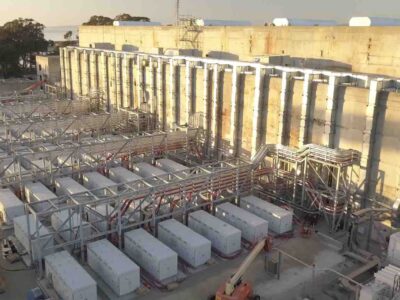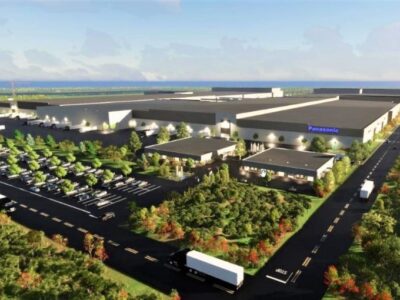(Bloomberg) —
This article is part of the Bloomberg Green series Timber Town , which looks at the global rise of timber as a low-carbon building material.
The University of Washington’s Founders Hall, which opened last year, is unlike any other building on the Seattle campus. Its beams, columns and central staircase are awash in warm hues thanks to the main construction material used: a strong engineered wood called mass timber. The bones of the new building lock in carbon dioxide digested by Pacific Northwest trees, and they should keep it out of the atmosphere for decades or longer.
Founders Hall is “forecasted to have a 76% [smaller] carbon footprint relative to a traditional concrete-steel structure” over the next 60 years or so, said Frank Hodge, dean of the university’s Foster School of Business. Features to conserve energy and water account for some of that, but a lot of it comes down to the material. “A big part of it is building with mass timber,” Hodge said.
Since buildings account for a whopping one-third of energy-related emissions, decarbonizing the sector has to happen, and fast, to keep warming within the limits set out in the Paris Agreement. Sustainable mass timber is a climate-friendly alternative to steel (the source of 7% of global emissions) or cement ( 8%), the key ingredient in concrete.
But there’s a hitch: Mass timber is still a niche product and usually costs more. The final price tag of Founders Hall was about $77 million, with a $4 million timber premium, according to Hodge.
Looking for ways to incentivize timber construction, a Boulder, Colorado-based climate tech company called Aureus Earth set out to design a new type of carbon offset. Offsets are a popular tool used by companies to balance their carbon spreadsheets. Purchased on a voluntary market, they are intended to make up for climate pollution generated across a business’s supply chain. The offset market hit $1.3 billion in 2022, according to tracking by Trove Research Ltd.
From the series: How a Seattle Architect Helped Make Timber Towers Legal in the US
With an offset, “you’re trying to compensate for or neutralize the effects of your pollution by purchasing something that induces a new climate benefit that would otherwise not happen,” said Danny Cullenward, a research fellow at American University’s Institute for Carbon Removal Law and Policy.
But growing scrutiny of offsets markets reveals that a lot of them don’t deliver on avoiding or reducing greenhouse gas emissions — for example, offsets may be based on exaggerated claims about forests’ carbon removal or could support renewable energy projects that would have been built regardless of credits being sold. And it’s not clear whether mass timber offsets can avoid the pitfalls that commonly ensnare other types of offsets.
In this case — which is so far a one-off for Aureus Earth — the company sought to put a value on the carbon dioxide stored in timber, sell it as a new type of offset and then let builders use that money to pay toward new construction. Collaborating with the University of Washington, the company last fall sold $150,000 of Founders Hall carbon offsets to a group of timber industry supporters and private foundations. (The university and Aureus Earth both declined to identify the purchasers further.)
Aureus Earth says it created a type of asset based on carbon storage that’s classified as real property, so the transaction was recorded by the local government in King County, Washington. But the parties are billing it as a “proof of concept” because the purchasers gifted the money back to the university.
“This is a way for us to show how this can be done,” said Hodge, “and hopefully in our small way, start a movement about how we can use a product that does not have as big a carbon footprint to build buildings.”
Valuing the carbon in columns and beams
In 2019, a team at Seattle-based LMN Architects cooked up three initial design concepts for Founders Hall: one with a concrete structure, another with steel, and a third using mostly mass timber. The third was the most distinctive and had a significantly lower environmental footprint, but would cost the most.
Hodge and his colleagues first settled on the concrete option. But if the incoming students were going to be thinking about climate change and sustainability, he realized, “then we’d better be thinking about that.” Weeks later, the university ended up pivoting to mass timber.
Offsets didn’t factor into the decision. “Aureus Earth was not even on the radar,” said Hodge. That came later, thanks to an introduction made by former executives in the forest products industry. It then took more than a year to sort out the pilot offset program and get the university’s stamp of approval.
First, Aureus Earth developed a detailed “protocol” to determine the exact amount of carbon dioxide equivalent (CO2e) stored in a mass timber building. This takes into account factors such as the distance trees traveled between forests and manufacturing facilities; different wood species; and wood moisture content, said Salmeron Barnes, co-founder and managing director of Aureus Earth.
The resulting protocol “really allows us to get an accurate number of tons stored in the structural elements of the building,” said Barnes. Parts of the building facade, which may be replaced over time, were not considered in the calculations.
Using that recipe, the company determined there were roughly 1,000 tons of CO2e stored in Founders Hall’s structure. Then the company established a value for those emissions — $150,000, or $150 per ton — using market research and negotiating with project sponsors. (“Future projects will take into account market rates,” among other factors, said Barnes.) Aureus Earth also helped find buyers for the newly minted carbon credits and facilitated the transaction.
“Ours was considered a symbolic transaction because the buyers of our sequestered carbon, the carbon credits, donated those back to the university once they were purchased” and the university is not using the offsets to reduce its emissions, said Hodge.
On its face, the transaction was a success. The university made a little money back, and Aureus Earth proved carbon offsets based on mass timber construction can have monetary value.
Greg Kats, a longtime investor in and expert on green buildings who’s now chief executive officer of the Smart Surfaces Coalition, and who was not involved in the project, sees potential in it. “The likelihood is that once you’d got a wood-built building or mass timber building, that wood is going to be, in essence, permanently sequestered because it’s such a high value product — there’s no way someone is going to landfill it,” he said, even if the building is eventually dismantled and replaced. Kats said he thinks offsets could help push more builders towards mass timber, especially as the product’s costs start to come down as manufacturing expands.
Is $150 per ton of CO2e, or even $100 per ton, enough to cover the extra cost of using cross-laminated timber? “The answer is, I think in many cases, yes,” he said.
Proving ‘additionality’
The big question surrounding most offsets, including potential timber ones, has to do with a wonky term called “additionality.” A climate project, such as choosing to build with mass timber, is additional if it would not have happened otherwise without the purchase of an offset.
“The claim is that the outcome is additional; the payment causes the new activity,” said Cullenward. “It’s sort of the gist of the whole thing.”
In the case of Founders Hall, the decision to go with mass timber was decidedly not additional. That’s because the university chose to use the climate-friendly material before the idea of offsets was ever discussed. So to Cullenward and other experts tracking carbon offsets, this specific proof of concept doesn’t really prove anything at all.
Whether future offsets based on mass timber could be additional is a different matter — and still an open question. Normally, offset protocols are publicly available, and there’s a section in them devoted to additionality. Aureus Earth doesn’t publicly disclose its mass timber protocol. But on its website, the company says it “minimizes the risk of non-additionality” by limiting the projects that qualify for offsets to early design phases, when the decision to use timber isn’t yet locked in, as well as by incentivizing long-term carbon storage in building materials.
Cullenward remains unconvinced. “I’m super skeptical of building-related applications precisely because it takes many, many years and so many permitting hurdles, and so much planning” to design and finish a large building, he said. “It’s not like you are carrying two ideas forward, just ready to switch with a little incentive. That’s highly implausible to me.”
From the series: Fire Fears After Grenfell Disaster Set Back Wood Building in UK
Barnes said that Aureus Earth’s goal is “to monetize the built environment’s ability to combat climate change.” “We realize that currently carbon offsets are not a perfect means to an end,” he said. “They are a means to an end.”
To that point, the company is working on “other financial products and incentive mechanisms” to further promote mass timber building and other more climate-friendly building materials, said Barnes. He declined to share specifics but added in a follow-up email: “In my opinion, any company that is basing its business model solely on the voluntary carbon markets is taking on a considerable amount of risk.”
There’s a silver lining in the Founders Hall experiment, though, according to Cullenward: “The idea that one could explore mass timber without that incentive being strictly necessary to move forward is a really positive thing to celebrate. Like, that’s exactly when climate-friendly practices are looking good, right?”
–With assistance from Akshat Rathi.
To contact the author of this story:
Zahra Hirji in Washington at zhirji@bloomberg.net
© 2023 Bloomberg L.P.





